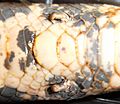Vestigial organ facts for kids
Vestigial organs are body parts that have become smaller and simpler over a very long time. They have lost most, or all, of their original use. Think of them like old tools that aren't needed anymore, so they've shrunk or changed.
These organs are important clues for understanding evolution. They only make sense if living things have changed over millions of years from their ancestors. Scientists realized that these parts were once useful adaptations in animals that lived long ago.
Vestigial organs appear in animals (and plants) that have changed how they live compared to their ancestors. For example, snakes lost their legs as they learned to move in a different way. But some snakes, like boas, still have tiny, leftover back legs and hip bones. The human vermiform appendix is another example. It used to be much bigger and helped our ancestors digest tough plant material. Now, it's much smaller and doesn't do that job anymore because our diet changed.
When a body part is no longer used, it usually gets smaller or disappears completely. For instance, amphibians that live in dark caves often lose their eyesight and body color. This happens because there's no benefit to keeping those features, and it takes energy to maintain them. Also, a part that's not used can sometimes get sick, like the human appendix can get appendicitis. So, there's a small advantage to losing parts that are no longer helpful.
Sometimes, a vestigial organ finds a new job! For example, the tiny bones in a mammal's ear, called ear ossicles, were once part of the jaw in early mammal ancestors. Another cool example is the halteres of flies. These tiny club-shaped organs used to be a second pair of wings, but now they help flies balance. This idea of an old part getting a new use is called exaptation.
How Body Parts Change
All body parts and their jobs develop and change because they affect an organism's fitness. Fitness means how likely an individual is to survive, reproduce, and pass on its genes to the next generation.
For example, if a frog can survive a bite from a venomous snake in its area, that increases its fitness. But if that frog lives somewhere with no venomous snakes, having a complicated way to survive snake venom might actually lower its fitness. Why? Because it still uses energy and resources to have that defense, even though it gets no benefit from it.
Everything in a living thing has a "cost." It either uses up energy to grow and maintain, or it takes up space that could be used for something else. So, if a body part isn't useful anymore, it's often better for the organism to lose it.
Images for kids
-
In humans, the vermiform appendix is a vestigial structure; it has lost most of its original job.
-
Letter c in the picture shows the undeveloped hind legs of a baleen whale.
See also
 In Spanish: Vestigialidad para niños
In Spanish: Vestigialidad para niños






